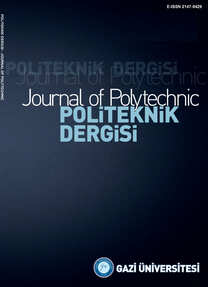The Effects of Solid Particle Erosion of ZrN Coating Material on GF/EP and CF/EP Composites by Using PVD Method
Solid particle erosion, ZrN coating, GF/EP, CF/EP, PVD
The Effects of Solid Particle Erosion of ZrN Coating Material on GF/EP and CF/EP Composites by Using PVD Method
Solid particle erosion, ZrN coating, GF/EP, CF/EP, PVD,
___
- [1] Srivastava V.K., “Effects of wheat starch on erosive wear of E-glass fiber reinforced epoxy resin composite materials”, Materials Science Engineering: A, 435-436: 282-287, (2006).
- [2] Mohan N., Mahesha C. R., Rajaprakash B. M., “Erosive wear behaviour of WC filled glass epoxy composites”, Procedia Engineering, 68: 694-702, (2013).
- [3] Yang L., Li H.L., Zhou Y.C., Zhu W., Wei Y.G., Zhang J.P.“Erosion failure mechanism of EB-PVD thermal barrier coatings with real morphology”, Wear, 392-393: 99-108, (2017).
- [4] Rout A.K. and Satapathy A., “Study on mechanical and tribo-performance of rice-husk filled glass–epoxy hybrid composites”, Materials & Design, 41: 131-141, (2012).
- [5] Mahapatra S.S., Patnaik A., “Study on mechanical and erosion wear behavior of hybrid composites using Taguchi experimental design”, Materials & Design, 30(8): 2791-2801, (2009).
- [6] Bagci M., “Determination of solid particle erosion with Taguchi optimization approach of hybrid composite systems”, Tribology International, 94: 336-345, (2016).
- [7] Shin D., Hamed A., “Influence of micro–structure on erosion resistance of plasma sprayed 7YSZ thermal barrier coating under gas turbine operating conditions”, Wear, 396-397: 34-47, (2018).
- [8] Maurer C., Schulz U., “Solid particle erosion of thick PVD coatings on CFRP”, Wear, 317: 246-253, (2014). [9] ASTM D3039 / D3039M-17, “Standard test method for tensile properties of polymer matrix composite materials”, ASTM International, West Conshohocken, PA, (2017). www.astm.org/cgi-bin/resolver.cgi?D3039D3039M-17
- [10] ASTM D2583-13a, “Standard test method for indentation hardness of rigid plastics by means of a Barcol impressor”, ASTM International, West Conshohocken, PA, (2013). www.astm.org/cgi-bin/resolver.cgi?D2583-13a
- [11] ASTM G76–95, “Standard test method for conducting erosion tests by solid particle impingement using gas jets”, ASTM International, West Conshohocken, PA, (2000). www.astm.org/cgi-bin/resolver.cgi?G76-95
- [12] Ruff A. W., Ives L.K., “Measurement of solid particle velocity in erosive wear”, Wear, 35: 195-199, (1975).
- [13] Finnie I., “Some reflections on the past and future of erosion”, Wear, 186-187(1): 1-10, (1995).
- [14] G., Roy M., “Solid particle erosion behaviour of metallic materials at room and elevated temperatures”, Tribology International, 30(5): 339-359, (1997).
- [15] Hutchings I.M., “Ductile-brittle transitions and wear maps for the erosion and abrasion of brittle material”, Journal of Physics D: Applied Physics, 25: 212-221, (1992).
- [16] Bagci M., “Influence of fiber orientation on solid particle erosion of uni/multidirectional carbon fiber/glass fiber reinforced epoxy composites”, Proceedings of the Institution of Mechanical Engineers, Part J: Journal of Engineering Tribology, 231(5): 594-603, (2017).
- [17] Azar G.T.P., Yelkarasi C., Ürgen M., “The role of droplets on the cavitation erosion damage of TiN coatings produced with cathodic arc physical vapor deposition”, Surface and Coatings Technology, 322: 211-217, (2017).
- ISSN: 1302-0900
- Yayın Aralığı: 6
- Başlangıç: 1998
- Yayıncı: GAZİ ÜNİVERSİTESİ
Özel Tip Bir Yarı Römork için Bağımsız Süspansiyon Sistemi Tasarımı: Kavramsal Tasarım Çalışmaları
Mehmet Murat TOPAÇ, Berk ÖZMEN, Uğur DERYAL, Orhun SELBES
A.Kürşat BİLGİLİ, Ömer AKPINAR, Gürkan KURTULUŞ, M. Kemal ÖZTÜRK, Süleyman ÖZÇELİK, Ekmel ÖZBAY
Modifiye Edilmiş NACA-0015 Kanat Yapısında Tüberkül Etkisinin Sayısal Analizi
Himmet Erdi TANÜRÜN, Adem ACIR
A Data Mining Application of Local Weather Forecast for Kayseri Erkilet Airport
Eda ÇINAROĞLU, Osman UNUTULMAZ
Cüneyt UYSAL, Mehmet Erdi KORKMAZ
Bahadır ERDOĞAN, Ali Bekir YILDIZ
Laminar Forced Convection Over An Inclined Flat Plate With Unheated Starting Length
Oğuz TURGUT, Ahmet Cem ÖZCAN, Haşmet TÜRKOĞLU
Investigation of Hardox 400 Steel Exposed to Heat Treatment Processes in WEDM
